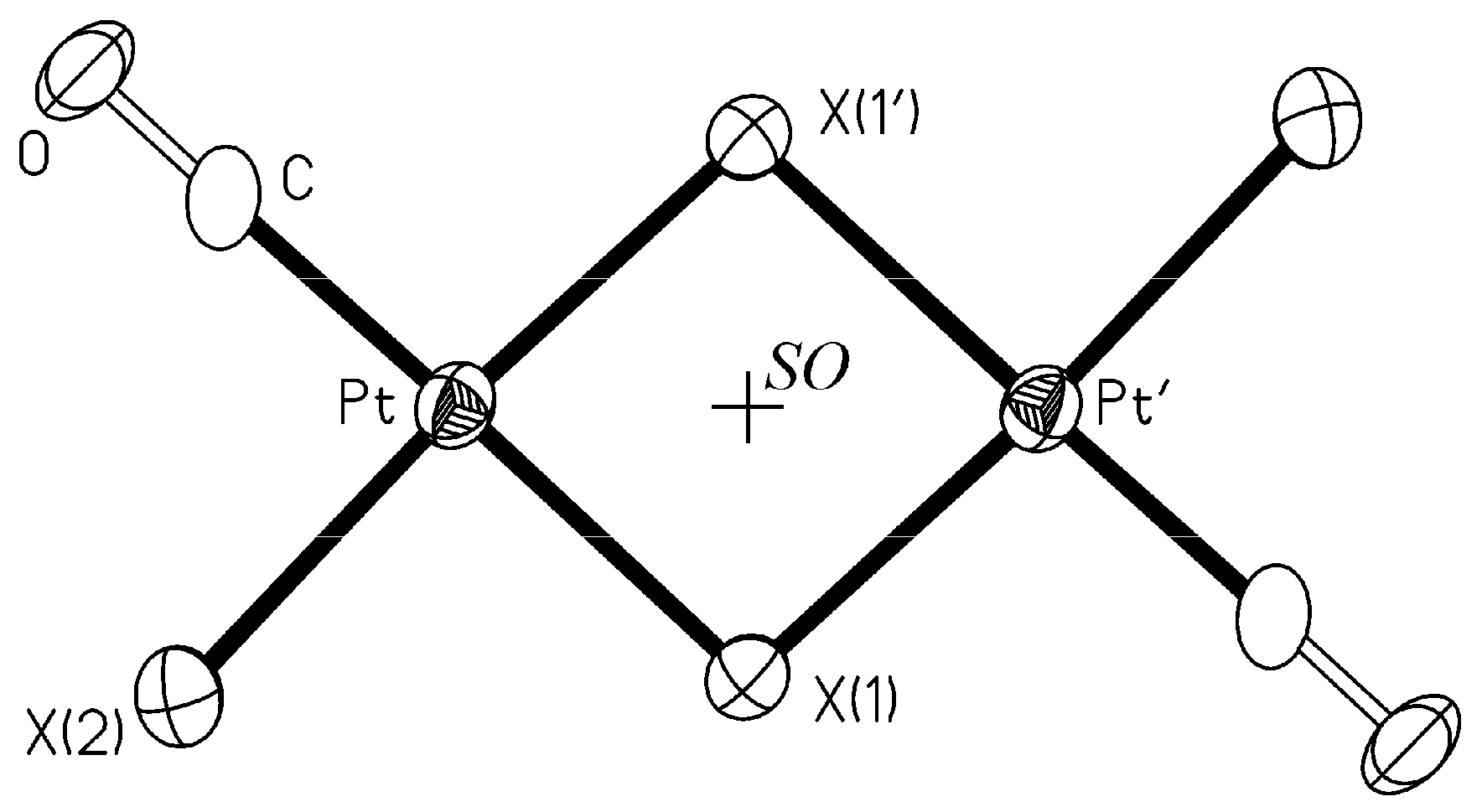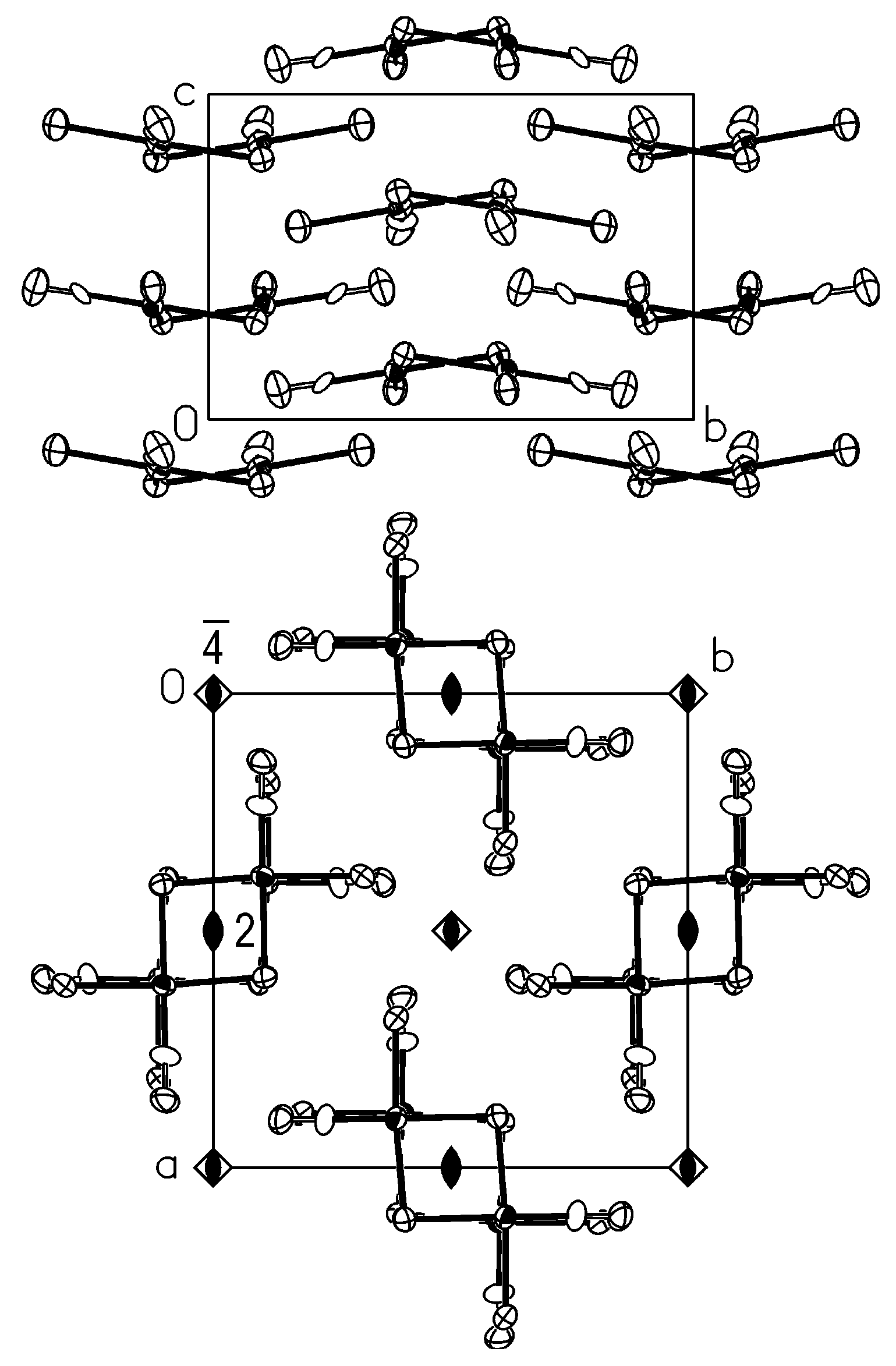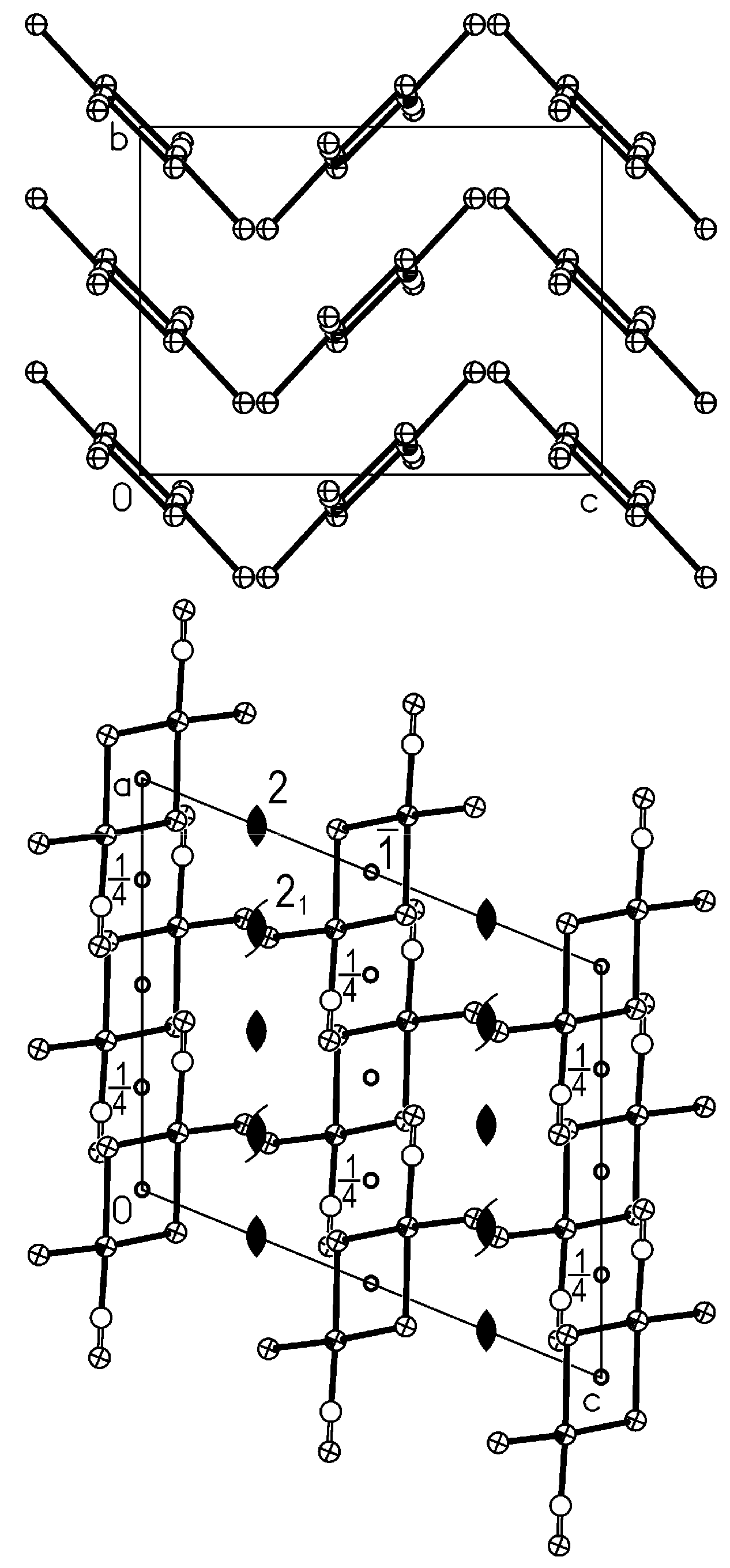Bent Dinuclear Platinum(II) Halo-Bridged Carbonyl Complexes
Abstract
:1. Introduction

2. Results and Discussion
 for X = Cl and I(α) and 2 for X = Br and I(β).
for X = Cl and I(α) and 2 for X = Br and I(β).
 for X = Cl and I(α) and 2 for X = Br and I(β).
for X = Cl and I(α) and 2 for X = Br and I(β).
 , which imposes two coplanar squares, while in the isotypic bent molecules trans-Pt2(μ-Br)2Br2(CO)2 and β-trans-Pt2(μ-I)2I2(CO)2 the operator is the twofold axis.
, which imposes two coplanar squares, while in the isotypic bent molecules trans-Pt2(μ-Br)2Br2(CO)2 and β-trans-Pt2(μ-I)2I2(CO)2 the operator is the twofold axis.| Cla | Brb | I(β)b | I(α)c | |
|---|---|---|---|---|
| Pt−X(1) | 2.284 | 2.464(2) | 2.608(3) | 2.622(3) |
| Pt−X(1') d | 2.392 | 2.457(2) | 2.620(4) | 2.630(2) |
| Pt−X(2) | 2.123 | 2.411(3) | 2.597(4) | 2.596(3) |
| Pt−C | 1.85 | 1.88(2) | 1.84(4) | 1.88(3) |
| C−O | 1.07 | 1.12(2) | 1.14(4) | 1.06(4) |
| Pt⋯Pt' | 3.441 | 3.579(1) | 3.760(3) | 3.846(2) |
| Pt⋯Pt'',e | 3.525 | 3.741(2) | 4.070(3) | -- |
| X(1)−Pt−X(2) | 93.96 | 90.34(8) | 90.39(11) | 90.68(10) |
| X(1)−Pt−X(1') | 85.29 | 85.65(8) | 85.29(10) | 85.83(10) |
| X(2)−Pt−C | 89.41 | 88.6(7) | 89.4(15) | 87.0(8) |
| X(1')−Pt−C | 91.34 | 95.4(8) | 94.9(16) | 96.50(8) |
| Pt−X(1)−Pt' | 94.71 | 93.31(7) | 91.97(9) | 94.17(10) |
| θ | 180 | 164.6 | 156.4 | 180 |

 operations, which imply columns are staggered. The molecules of each column are bent in the same direction, while those of the nearest neighbour columns are bent in the opposite direction.
operations, which imply columns are staggered. The molecules of each column are bent in the same direction, while those of the nearest neighbour columns are bent in the opposite direction.

3. Experimental
3.1. General
3.2. Preparation of trans-Pt2(μ-Br)2Br2(CO)2
3.3. Crystallography
 21c. All the atoms were refined with anisotropic thermal parameters. The final refinement cycles gave the reliability factors listed in Table 2.
21c. All the atoms were refined with anisotropic thermal parameters. The final refinement cycles gave the reliability factors listed in Table 2.| Compound | trans-Pt2(μ-Br)2Br2(CO)2 | β-trans-Pt2(μ-I)2I2(CO)2 |
|---|---|---|
| Empirical formula | C2Br4O2Pt2 | C2I4O2Pt2 |
| Formula weight | 765.78 | 953.78 |
| Crystal system | Tetragonal | Tetragonal |
| Space group | P  21c (No. 114) 21c (No. 114) | P  21c (No. 114) 21c (No. 114) |
| a / Å | 11.522(1) | 12.125(1) |
| c / Å | 7.475(2) | 8.132(1) |
| U / Å3 | 992.4(3) | 1195.5(2) |
| Z | 4 | 4 |
| Dcalc / Mg·m−3 | 5.125 | 5.299 |
| μ / mm−1 | 44.213 | 33.662 |
| No. measured | 2148 | 1640 |
| No. unique [Rint] | 1033 [0.0513] | 775 [0.1089] |
| No. parameters | 48 | 48 |
| R1, wR2 [I>2σ(I)] | 0.0478, 0.0798 | 0.0517, 0.0857 |
| R1, wR2 (all data) | 0.0973, 0.0937 | 0.1325, 0.1093 |
| Goodness of fit on F2 | 0.991 | 0.899 |
4. Conclusions
Acknowledgements
References
- Aullón, G.; Ujaque, G.; Lledós, A.; Alvarez, S.; Alemany, P. To Bend or Not To Bend: Dilemma of the Edge-Sharing Binuclear Square Planar Complexes of d8 Transition Metal Ions. Inorg. Chem. 1998, 37, 804–813. [Google Scholar]
- Jain, V.K.; Jain, L. The chemistry of binuclear palladium(II) and platinum(II) complexes. Coord. Chem. Rev. 2005, 249, 3075–3197. [Google Scholar] [CrossRef]
- Simms, B.L.; Ibers, J.A. Formation of a σ-Cyclobutyl-Platinum Bond by the Intramolecular Activation of a Cyclobutylphosphine. Synthesis and Structure of [Pt(P(t-Bu)2CH2CHCH2CH2CH)]2(μ-Br)2. J. Organomet. Chem. 1987, 330, 279–289. [Google Scholar]
- Braunschweig, H.; Radacki, K.; Uttinger, K. Syntheses of Mono- and Dinuclear Diiodoboryl Complexes of Platinum. Inorg. Chem. 2007, 46, 8796–8800. [Google Scholar]
- Braunschweig, H.; Brenner, P.; Radacki, K. A Bromidebridged Platinum(II) Complex as Precursor to a Neutral Platinum Compound with a BaseStabilized Borylene Ligand. Z. Anorg. Allg. Chem. 2009, 635, 2089–2092. [Google Scholar] [CrossRef]
- Dahl, L.; Martell, C.; Wampler, D. Structure and Metal-Metal Bonding in Rh(CO)2Cl. J. Am. Chem. Soc. 1961, 83, 1761–1762. [Google Scholar]
- Walz, L.; Scheer, P. Structure of di-μ-chloro-bis[dicarbonylrhodium(I)]. Acta Crystallogr. Sect. C Cryst. Struct. Commun. 1991, 47, 640–641. [Google Scholar] [CrossRef]
- Allen, F.H. The Cambridge Structural Database: A quarter of a million crystal structures and rising. Acta Cryst. 2002, B58, 380–388. [Google Scholar]
- Abdul Malik, K.M.; Newman, P.D. Ligand ambivalence in pallada(platina)cyclic complexes of a rigid phosphine. Dalton Trans. 2003, 3516−3525. [Google Scholar]
- Seidel, S.; Seppelt, K. The Platinum Catalyst [bpyrPtCl2] in Superacidic Solution. Inorg. Chem. 2003, 42, 3846–3848. [Google Scholar]
- Brune, H.-A.; Roth, H.; Debaerdemaeker, T.; Schiebel, H.-M. Synthese und Struktur des Bis[tetra(n-butyl) ammonium]-bis{[μ-bromo]2,2′-η2-[4,4′-bis(trifluormethyl)biphenyl] platinat (II)}. Organomet. Chem. 1991, 402, 435–442. [Google Scholar]
- Bedford, R.B.; Dumycz, H.; Haddow, M.F.; Pilarski, L.T.; Orpen, A.G.; Pringle, P.G.; Wingad, R.L. Chiral triaryl phosphite-based palladacycles and platinacycles: synthesis and application to asymmetric Lewis acid catalysis. Dalton Trans. 2009, 7796–7804. [Google Scholar]
- Forniés, J.; Fortuño, C.; Gil, R.; Martín, A. Tetranuclear Platinum Phosphido Complexes with Different Structures. Inorg. Chem. 2005, 44, 9534–9541. [Google Scholar]
- Alyea, E.C.; Ferguson, G.; Malito, J.; Ruhl, B.L. Crystal and Molecular Structures of Bis(μ-chloro)bis[o-(dimesitylphosphino)-3,5-dimethylbenryl]-dipalladium(II) Acetone Solvate, [Pd(P(mes)2C6H2(CH3)2CH2)Cl]2·2(CH3COCH3), and its Platinum Analogue [Pt(P(mes)2 C6H2(CH3)2CH2)Cl]2·2(CH3COCH3). Cyclometalated Complexes of the Bulkiest Known Phosphine Trimesitylphosphine. Organometallics 1989, 8, 1188–1191. [Google Scholar] [CrossRef]
- Belli Dell’Amico, D.; Labella, L.; Marchetti, F.; Samaritani, S. Halo-carbonyl complexes of palladium, platinum and gold. Coord. Chem. Rev. 2010, 254, 635–645. [Google Scholar] [CrossRef]
- Bagnoli, F.; Belli Dell’Amico, D.; Calderazzo, F.; Englert, U.; Marchetti, F.; Merigo, A.; Ramello, S. Halo-carbonyl complexes of platinum(II) and palladium(II). J. Organomet. Chem. 2001, 622, 180–189. [Google Scholar]
- Clemente, D.A.; Marzotto, A. 30 Space-group corrections: two examples of false polymorphism and one of incorrect interpretation of the fine details of an IR spectrum. Acta Cryst. 2004, B60, 287–292. [Google Scholar]
- Andreini, B.P.; Belli Dell’Amico, D.; Calderazzo, F.; Venturi, M.G.; Pelizzi, G.; Segre, A. Carbonyl complexes of noble metals with halide ligands I. Platinum(II)/halide exchange, dimerization, isomerization, 13C-NMR data and crystal and molecular structure of Pt2I4(CO)2. J. Organomet. Chem. 1988, 354, 357–368. [Google Scholar]
- XSCANS, X-ray Single Crystal Analysis System, Rel. 2.1.; Bruker AXS Inc.: Madison, WI, USA, 1994.
- Sheldrick, M. SHELXTL-Plus, Rel. 5.1.; Bruker AXS Inc.: Madison, WI, USA, 1997. [Google Scholar]
- Sample Availability: Not available
© 2011 by the authors; licensee MDPI, Basel, Switzerland. This article is an open access article distributed under the terms and conditions of the Creative Commons Attribution license ( http://creativecommons.org/licenses/by/3.0/).
Share and Cite
Dell'Amico, D.B.; Labella, L.; Marchetti, F. Bent Dinuclear Platinum(II) Halo-Bridged Carbonyl Complexes. Molecules 2011, 16, 6082-6091. https://doi.org/10.3390/molecules16076082
Dell'Amico DB, Labella L, Marchetti F. Bent Dinuclear Platinum(II) Halo-Bridged Carbonyl Complexes. Molecules. 2011; 16(7):6082-6091. https://doi.org/10.3390/molecules16076082
Chicago/Turabian StyleDell'Amico, Daniela Belli, Luca Labella, and Fabio Marchetti. 2011. "Bent Dinuclear Platinum(II) Halo-Bridged Carbonyl Complexes" Molecules 16, no. 7: 6082-6091. https://doi.org/10.3390/molecules16076082
APA StyleDell'Amico, D. B., Labella, L., & Marchetti, F. (2011). Bent Dinuclear Platinum(II) Halo-Bridged Carbonyl Complexes. Molecules, 16(7), 6082-6091. https://doi.org/10.3390/molecules16076082




